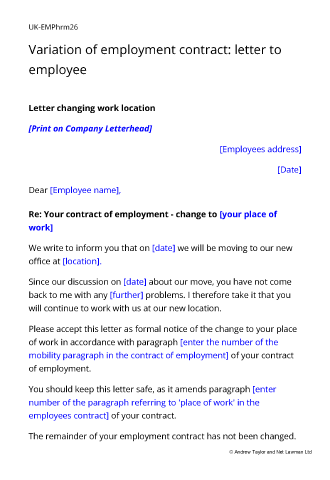Variation of employment contract

Document overview

 England & Wales
England & Wales Scotland
Scotland

- Length:5 pages (1100 words)
- Available in:
 Microsoft Word DOCX
Microsoft Word DOCX Apple Pages
Apple Pages RTF
RTF

If the document isn’t right for your circumstances for any reason, just tell us and we’ll refund you in full immediately.

We avoid legal terminology unless necessary. Plain English makes our documents easy to understand, easy to edit and more likely to be accepted.

You don’t need legal knowledge to use our documents. We explain what to edit and how in the guidance notes included at the end of the document.

Email us with questions about editing your document. Use our Lawyer Assist service if you’d like our legal team to check your document will do as you intend.

Our documents comply with the latest relevant law. Our lawyers regularly review how new law affects each document in our library.
About these change to employment terms letters
Circumstances change and your business may need to vary the terms under which your employees work in order to adapt.
Under employment law, any changes to en employee’s terms and conditions must be recorded.
This pack of documents includes five letters that address the most frequent changes to an employment contract. Of course they can be amended to suit other, less common variations too, including situations that may not be to the benefit of the employee.
They are:
to notify of a change in the work location - for example, the business may have moved premises, or the employee may be required to work at another location for a significant period of time as a result of a change in responsibilities.
to vary work status - for example, you may be asking a part-time employee to work full-time
to increase pay - this may include benefits such as increased sick pay or changes to bonus calculations as well as standard remueration
to change the employee’s role and responsibilities - likely to be small changes as a result of increased experience, new business requirements or a reshuffle of who does what in a team
to increase annual leave
Also included are additional letters that:
confirm to the employee that the remainder of the employment contract has not been changed
allow the employee to dispute the changes
These letters are suitable to be given to employees based in England and Wales.
How changes can be made to employment terms
There are three ways by which employment contracts can be changed:
by mutual agreement between the employer and the employee
by collective agreement, if the employee is represented by a trade union or staff association and those representatives negotiate for the change
by implication if the employee continues to work after the change for a reasonably sufficient time period
Implied acceptance of a change of employment terms is subjective and therefore difficult to establish. If the change benefits the employee (such as a pay rise or beneficial overtime entitlements or establishing a custom to give New Year's Eve as an additional day of paid holiday leave) then there is less risk that it might be disputed.
Other changes without agreement that may not benefit the employee, such as relocation to another place of work or variation of duties, might be more enforceable if the employment contract states clearly that they might change. Whether or not they are reasonable and therefore enforceable remains subjective. Changes that are not reasonably possible to comply with, such as the moving of the workplace to somewhere far away or significant changes to working hours may be disputed.
Regardless of whether the employer has a legal right to impose a change, it is always beneficial to the employer-employee relationship if the employer notfies the affected employees by letter setting out the reasons for change.
After notifying the employee
At the same time as sending the change to employment terms letter you should organise a consultation meeting.
The purpose of a consultation meeting is to allow the employer to explain how the changes will affect the employee in more details and allow the employee to ask questions, discuss how the changes will be implemented, identify and propose alternative ideas and, perhaps, let the employer know of future plans such as bringing forward retirement plans.
If the employment agreement does not give a contractual right to make the proposed change then having a consultation meeting with the employee is a way of ensuring that you follow a ‘fair’ process, which itself is important to demonstrate if the employee later claims constructive dismissal.
Additionally at the meeting, or shortly after, you might ask the employee to confirm acceptance of the changes in some way. Having written evidence of the employee's consent to the proposed changes to employment protects you from later claims that they were not accepted. You might ask the employee to return a letter template that you have prepared, or ask them to write on a copy of your letter confirming their acceptance along with the date of acceptance and their signature.

Recent reviews
Choose the level of support you need
Document Only
This document
Detailed guidance notes explaining how to edit each paragraph
Lawyer Assist
This document
Detailed guidance notes explaining how to edit each paragraph
Unlimited email support - ask our legal team any question related to completing the document
- Review of your edited document by our legal team including:
- reporting on whether your changes comply with the law
- answering your questions about how to word a new clause or achieve an outcome
- checking that your use of defined terms is correct and consistent
- correcting spelling mistakes
- reformatting the document ready to sign
All rights reserved
